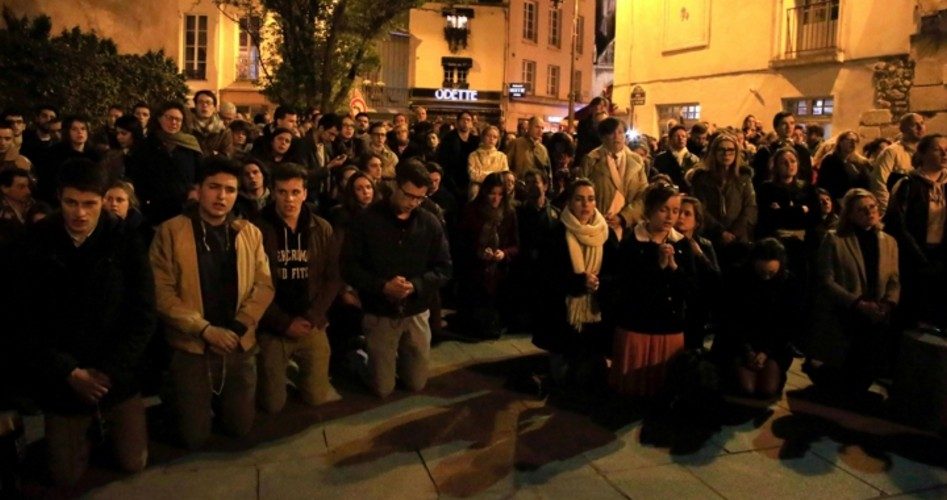
Notre Dame Cathedral has stood for over 800 years. It survived the French Revolution and the Napoleonic Wars. It survived World Wars I and II. Monday night, the cathedral stood on the brink of destruction due to a raging inferno that has severely damaged the French Gothic structure, toppled the spire, and caved in the roof. A symbol of Christianity in France, across Europe, and around the world, Notre Dame narrowly survived Monday’s fire. But what of the Christian Faith that the cathedral symbolizes?
Beginning with the baptism of Clovis on Easter Day in 508, France became the first Christian nation. That played a major part in the history of France, Europe, and the world. As part of the Christian heritage of France, Notre Dame Cathedral was built beginning in 1160, and mostly completed by 1260. Generations of craftsman spent their entire working lives building Notre Dame — with many of them seeing their labor as an act of worship to God.
Henry VI of England had his coronation as king of France there in 1431. In 1804, the coronation of Napoleon I (Bonaparte) as emperor of France was held there. In fact, it was in 1801 that Napoleon signed an agreement with the Holy See allowing the Catholic Church to resume control of Notre Dame. He made provisions to ensure that needed repairs would be completed in time for his coronation. Notre Dame has been the site of Royal weddings dating back to the wedding of James V, king of Scotland and Madeleine of Valois in 1537.
Much of the repair work between 1801 and 1804 in preparation for Napoleon’s coronation was needed because of the damage done to the cathedral in the dark days of the French Revolution. During the barbarism of the revolution, Notre Dame — which had already seen damage at the hands of King Louis XIV — was viewed by the “enlightened” Jacobin revolutionaries as a symbol of the power of both Christianity and the monarchy, both of which were targets of the revolution. The cathedral was ravaged, with sculptures and statues destroyed and the roof stripped of much of its lead for the making of bullets to be used by the revolutionaries. Many minor bronze bells were smelted down to forge cannon, though the great bells somehow escaped that fate.
Perhaps worst of all, the building itself — constructed as a place of worship to God and for His glory — was repurposed into a “church” for the atheistic “Cult of Reason” in 1793 before schism within the ranks of the revolutionaries led to the cathedral becoming a “church” for the deist “Cult of the Supreme Being.” During this same time, the cathedral was used as a warehouse by the revolutionaries. This desecration was only the beginning of the indignities the cathedral would witness.
The vandalism and pillaging of the cathedral — combined with the religious and historical ignorance of the barbarian revolutionaries — led to 28 statues of Biblical kings being beheaded (since the revolutionaries mistook them for French Kings). All other statues, with the exception of one statue of the Virgin Mary, were destroyed. The statue of the Virgin Mary, for whom the cathedral was named (Notre-Dame de Paris is French for “Our Lady of Paris”) was perhaps only spared because the revolutionaries co-opted her as Marrianne, the Goddess of Liberty.
Once the French Revolution was finally over, Napoleon — as mentioned above — allowed Notre Dame to return to the control of the Catholic Church and begin the needed repairs. Even when Napoleon’s arrogance and avarice caused him to divorce himself from his Christian faith and wage war both across Europe and against religion, Notre Dame remained safe.
The cathedral again saw dark days during WWI when it was shelled by the Germans in 1914. The fire caused the lead that sealed the roof to become molten hot and run down, igniting the pews inside the church. During the shelling, several stained glass windows were destroyed along with many pillars and statues, according to reports by the Washington Post at the time.
WWII was again a trying time for Notre Dame. With German occupation a foregone conclusion and Hitler’s hatred of Christianity well known, the cathedral’s famous stained glass windows — including the three rose windows that date back to the 1200s — were removed and taken away for safety. They were reinstalled only after France was liberated from Germany at the conclusion of the war.
Notre Dame — as a symbol of Christianity — has withstood the attack of those who are its enemies because they are the enemies of the faith for which it stands as that symbol. Monday’s inferno can also be seen as a symbol. The fire stood a very real chance of destroying the cathedral. Even if that had happened — and thank God it did not — the reality for which Notre Dame stands would have remained.
As stories emerge, the survival of Notre Dame is one amazement after another. The fire raged for more than nine hours, the damage is the greatest the cathedral had ever seen. The roof collapsed; the spire toppled; but the edifice remains. Though mass was being said in the cathedral when the fire broke out, everyone was able to escape. No injuries have been reported.
A Paris Fire Brigade chaplain, Father Jean-Marc Fournier, who was hailed as a hero after he tended to victims after the 2015 terror attack in that city, is again being called a hero. This time, he entered the burning building and retrieved priceless relics to save them from the fire, according to a report by CNN. One of the relics he rescued from the fire is a fragment of the Crown of Thorns forced on Jesus during His Passion. Other relics that escaped the fire include a fragment of the Cross on which Christ was crucified.
The rose windows appear to be intact. The major bells — which have already escaped destruction in the past — were also preserved. This includes the bourdon (named Emmanuel), which has rung for hundreds of years to mark major events in France, including the end of the World Wars and in solidarity with the United States after the terrorist attacks of 9/11.
Perhaps the most amazing picture to emerge from the aftermath of the fire is of the candles — lit by the faithful in prayer in the hours before the fire broke out. CNN’s report of the aftermath includes a picture of those candles. Even after more than nine hours of intense heat and all of the falling debris — even with all of the water used to fight the fire — the picture shows the candles intact and still burning — a symbol of the prayers of the faithful going up to God.
With the fire extinguished and the edifice intact, there are already plans to rebuild. French President Emmanuel Macron has reached out to the world to raise the needed funds to restore Notre Dame. As of this writing, nearly $1 billion has been pledged to the restoration of this symbol of Christianity. Funds have been pledged by wealthy individuals, companies, and religious groups.
Notre Dame will be rebuilt. Thank God.
The enemies of God and man have tried for 2,000 years to destroy Christianity — tried and failed. Even in largely post-Christian France, the Christian Faith is still a part of the subconscious thinking (at least) of the French people.
While the fire was burning and firefighters worked to contain and extinguish it, the streets of Paris were filled to overflowing with people kneeling, praying, and singing hymns — asking God to save the cathedral and help Paris, all of France, Europe, and the world to bear the pain of what they were witnessing. God has answered those simple, faithful prayers. If this is a sign that France may again turn to God, it is a good sign.
Clovis would be pleased.
Photo of people praying during the Notre Dame fire: Sipa via AP Images




